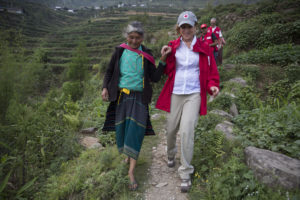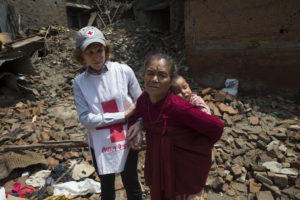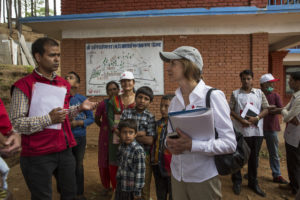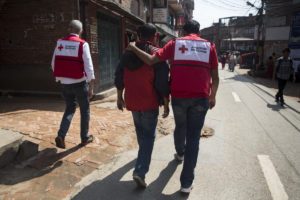In my seven years at the helm of the American Red Cross, I’ve seen far too many disasters – both here at home and around the world. But no matter how many disasters I experience – I’ll never get used to witnessing scenes of destruction on a massive scale. I just returned from Nepal, and the devastation I saw there was truly heartbreaking.
Homes, businesses, and schools were destroyed; entire communities were flattened; and tens of thousands were injured or killed by the 7.8 magnitude earthquake that struck on April 25th. While heavy damage occurred in certain pockets of Kathmandu, many villages in remote areas were also severely impacted. Often these villages are very hard to find on a map and are lacking in even the most basic infrastructure. In fact, one Nepalese man told me that to get from Kathmandu to the village where his family lived before the earthquake, he had to take a 36 hour bus ride and then hike 9 hours.
 Even in the midst of such terrible tragedy, the Nepalese people that I met with are among the most gentle and kind-hearted I’ve encountered. The landscape there is rough and rocky – and we had to hike over hilly terrain to get a sense of the damage done in more isolated communities. At one point during our trek, I was struggling to keep my footing on a particularly treacherous stretch of hillside. Seemingly out of nowhere, an elderly Nepalese woman grabbed my arm and helped safely guide me down the hill.
Even in the midst of such terrible tragedy, the Nepalese people that I met with are among the most gentle and kind-hearted I’ve encountered. The landscape there is rough and rocky – and we had to hike over hilly terrain to get a sense of the damage done in more isolated communities. At one point during our trek, I was struggling to keep my footing on a particularly treacherous stretch of hillside. Seemingly out of nowhere, an elderly Nepalese woman grabbed my arm and helped safely guide me down the hill.
 In another area we visited, I met a woman who was carrying her grandson in a very large pack on her back. I climbed up a large pile of rubble with her to see what remained of her home, which had been located on the top floor of a three story building before the earthquake hit. Once we reached the top of the pile, there was a fleeting moment where she seemed overwhelmed by the magnitude of what she was seeing. She grabbed my hand, and suddenly I was the one helping her climb down to safety. In that moment, I was reminded of the common bonds we all share and the vital importance of having someone there to provide support when you need it.
In another area we visited, I met a woman who was carrying her grandson in a very large pack on her back. I climbed up a large pile of rubble with her to see what remained of her home, which had been located on the top floor of a three story building before the earthquake hit. Once we reached the top of the pile, there was a fleeting moment where she seemed overwhelmed by the magnitude of what she was seeing. She grabbed my hand, and suddenly I was the one helping her climb down to safety. In that moment, I was reminded of the common bonds we all share and the vital importance of having someone there to provide support when you need it.
 One of the most remarkable scenes I witnessed occurred when we stopped at a school that had been mostly destroyed in the disaster. Thankfully classes were not in session when the earthquake hit. And in a wonderful act of community resiliency, the students who normally attended class in the building had turned what remained of the structure into a field hospital of sorts. Upwards of 450 young people were working there – caring for the injured, handing out relief supplies and administering basic first aid. As it turns out, the students had been previously trained in preparedness activities through a partnership with the American Red Cross, the Nepal Red Cross and one of our generous donors that was active in a number of Nepalese schools. In the midst of such destruction and heartbreak, it was an amazingly uplifting moment to see so many young people actively helping their neighbors using the training they had received in a more peaceful time.
One of the most remarkable scenes I witnessed occurred when we stopped at a school that had been mostly destroyed in the disaster. Thankfully classes were not in session when the earthquake hit. And in a wonderful act of community resiliency, the students who normally attended class in the building had turned what remained of the structure into a field hospital of sorts. Upwards of 450 young people were working there – caring for the injured, handing out relief supplies and administering basic first aid. As it turns out, the students had been previously trained in preparedness activities through a partnership with the American Red Cross, the Nepal Red Cross and one of our generous donors that was active in a number of Nepalese schools. In the midst of such destruction and heartbreak, it was an amazingly uplifting moment to see so many young people actively helping their neighbors using the training they had received in a more peaceful time.
The people of Nepal are displaying incredible resilience, and they are eager to rebuild. In addition to committing an initial $5,000,000 to the response operation, the American Red Cross is working closely with the Nepal Red Cross and the global Red Cross network to help coordinate ongoing activities. We’re providing remote mapping and information management assistance. We’re also coordinating relief supplies from warehouses in Kuala Lumpur and Dubai. Additionally, nine American Red Cross disaster specialists are in Nepal – supporting emergency relief, cash transfer programing, information management, recovery planning and IT/telecoms services – and one expert has been deployed to Geneva to support global Red Cross efforts online. We’re also developing preliminary plans with the Nepal Red Cross to do long term recovery – targeting villages to help rebuild.

But even with the outpouring of support from the global community, the need in Nepal remains tremendous. While I was traveling back to the United States earlier this week, another 7.3 magnitude earthquake struck there – further damaging infrastructure and causing more injuries and loss of life.
There is no doubt that it will take a great deal of time and resources for Nepal to recover from this trying period, and it’s vitally important the global community extends a hand of friendship and assistance to those in need. There are three main ways to support the ongoing relief work. You can donate to help the people of Nepal by visiting redcross.org. You can also volunteer to assist with our online mapping efforts by going to http://tasks.hotosm.org. You don’t need to be a tech expert to help, you just need a computer and an Internet connection. And you can also support the people of Nepal by sharing word about relief efforts and ways to help on social media channels.
While I’m still incredibly saddened when I think of the lives lost, the homes destroyed, and the communities that have been forever altered in Nepal – I also return home encouraged by the tremendous work of the global Red Cross network and our partners in the ongoing response operation. There certainly is a long road ahead, but I believe the people of Nepal have reason for hope given the incredible generosity of so many.
